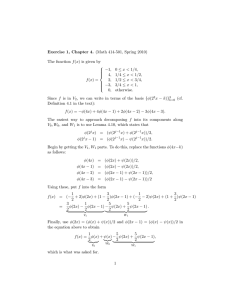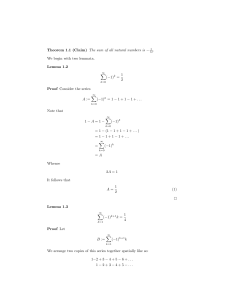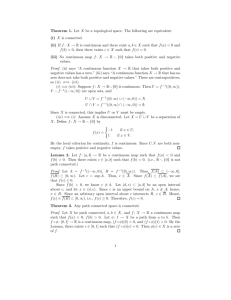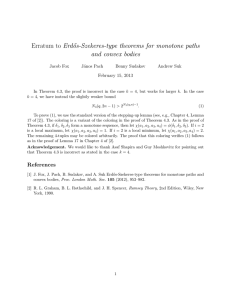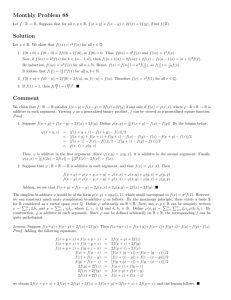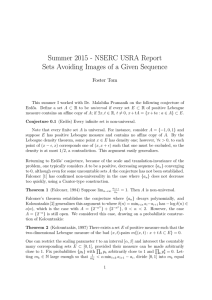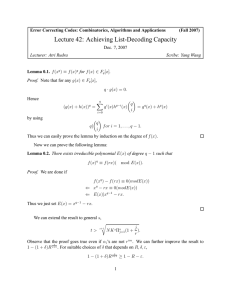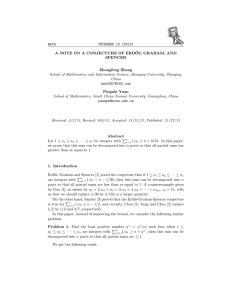#A18 INTEGERS 10 (2010), 229-232 Chi-Wu Tang
advertisement
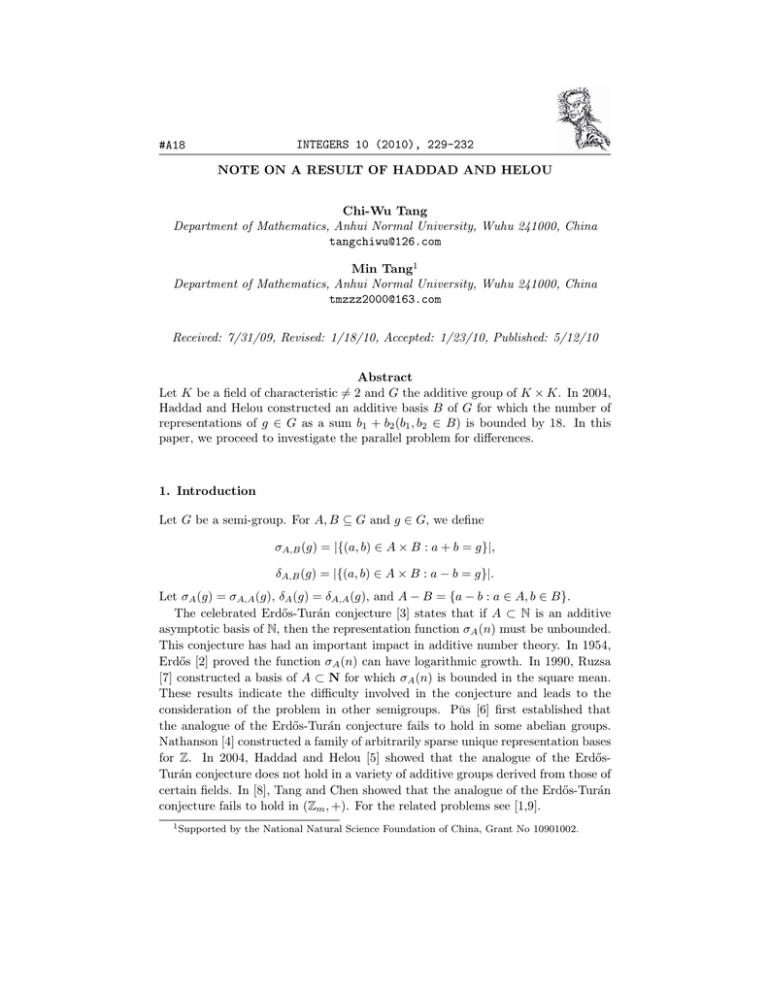
INTEGERS 10 (2010), 229-232
#A18
NOTE ON A RESULT OF HADDAD AND HELOU
Chi-Wu Tang
Department of Mathematics, Anhui Normal University, Wuhu 241000, China
tangchiwu@126.com
Min Tang1
Department of Mathematics, Anhui Normal University, Wuhu 241000, China
tmzzz2000@163.com
Received: 7/31/09, Revised: 1/18/10, Accepted: 1/23/10, Published: 5/12/10
Abstract
Let K be a field of characteristic != 2 and G the additive group of K × K. In 2004,
Haddad and Helou constructed an additive basis B of G for which the number of
representations of g ∈ G as a sum b1 + b2 (b1 , b2 ∈ B) is bounded by 18. In this
paper, we proceed to investigate the parallel problem for differences.
1. Introduction
Let G be a semi-group. For A, B ⊆ G and g ∈ G, we define
σA,B (g) = |{(a, b) ∈ A × B : a + b = g}|,
δA,B (g) = |{(a, b) ∈ A × B : a − b = g}|.
Let σA (g) = σA,A (g), δA (g) = δA,A (g), and A − B = {a − b : a ∈ A, b ∈ B}.
The celebrated Erdős-Turán conjecture [3] states that if A ⊂ N is an additive
asymptotic basis of N, then the representation function σA (n) must be unbounded.
This conjecture has had an important impact in additive number theory. In 1954,
Erdős [2] proved the function σA (n) can have logarithmic growth. In 1990, Ruzsa
[7] constructed a basis of A ⊂ N for which σA (n) is bounded in the square mean.
These results indicate the difficulty involved in the conjecture and leads to the
consideration of the problem in other semigroups. Pǔs [6] first established that
the analogue of the Erdős-Turán conjecture fails to hold in some abelian groups.
Nathanson [4] constructed a family of arbitrarily sparse unique representation bases
for Z. In 2004, Haddad and Helou [5] showed that the analogue of the ErdősTurán conjecture does not hold in a variety of additive groups derived from those of
certain fields. In [8], Tang and Chen showed that the analogue of the Erdős-Turán
conjecture fails to hold in (Zm , +). For the related problems see [1,9].
1 Supported
by the National Natural Science Foundation of China, Grant No 10901002.
230
INTEGERS: 10 (2010)
It is natural to consider the parallel problems for differences. In this paper, based
on the methods of Haddad and Helou, we obtain the following result.
Theorem 1. Let K be a finite field of characteristic != 2 and G the additive group
of K × K. Then there exists a set B ⊂ G such that B − B = G, and δB (g) ≤ 14
for all g != 0.
Remark 2. This result is a generalization of the result obtained by Tang [10,
Lemma 3]. For example, let p be prime with p ≥ 3. By the theorem, there exists a
set B ⊂ Zp × Zp such that B − B = G and δB (g) ≤ 14 for all g != 0.
Throughout this paper, let K be a field of characteristic != 2 and G the additive
group of K × K. We denote by K ∗ = K \ {0} the multiplicative group of K and by
S(K ∗ ) = {x2 : x ∈ K ∗ } the subgroup of the square elements of K ∗ . For k ∈ K ∗ ,
let Qk = {(u, ku2 ) : u ∈ K} ⊂ G.
2. Proofs
Lemma 3. For g = (a, b) ∈ G and fixed k, l ∈ K ∗ , consider the equation
g = x − y, x ∈ Qk , y ∈ Ql .
If k − l != 0, then the set Qk − Ql consists of all the elements (a, b) ∈ G such that
b(k − l) + a2 kl is a square in K, and for any g ∈ G, δQk ,Ql (g) ≤ 2. If k − l = 0, it
has at most one solution except if g = 0, when it has |K| solutions.
Proof. Let g = (a, b) ∈ G. Consider the system of equations
a = u − v,
(1)
b = ku2 − lv 2 .
(2)
b = (k − l)v 2 + 2kav + ka2 .
(3)
Substituting the value of u from (1) into (2), we get the equation
Case 1. k − l != 0. This is a quadratic equation in v, and it has exactly one or two
solutions
in the "field K if and only if its discriminant 4a2 k2 − 4(k − l)(a2 k − b) =
!
4 (k −l)b+kla2 is a square in K. Since the characteristic of K is != 2, the non-zero
square factor 4 can be discarded in the latter condition. Thus for any g = (a, b) ∈ G,
we have δQk ,Ql (g) ≤ 2.
Case 2. Case 2. k − l = 0. Then (3) is an equation of degree 1. If a != 0, (3) has
one solution. If a = b = 0, (3) has |K| solutions. If a = 0, b != 0, (3) has no solution.
This completes the proof of Lemma 3.
!
231
INTEGERS: 10 (2010)
Lemma 4 [5, Lemma 3.7]. If K is a finite field of characteristic != 2, then the index
of the subgroup S(K ∗ ) in the multiplicative group of K ∗ is 2. Thus the product of
two non-square elements of K ∗ is a square element of K ∗ .
Lemma 5. If K is a finite field of characteristic != 2 and |K| ≥ 5, then there exist
elements j, k ∈ K ∗ such that j ∈ S(K ∗ ), k !∈ S(K ∗ ), and k != −j.
Proof. By Lemma 4, S(K ∗ ) != K ∗ and |S(K ∗ )| = |K ∗ |/2 ≥ 2, thus we can choose
j ∈ S(K ∗ ), k ∈ K ∗ \ S(K ∗ ), and k != −j.
!
Proof of Theorem 1. If K = F3 = {0, 1, 2}, put B = {(0, 0), (0, 1), (0, 2),
(1, 1), (2, 0)} ⊂ F3 × F3 . Then we have B − B = G and δB (g) ≤ 3 for all g != 0.
Now we consider K to be a finite field of characteristic != 2 and |K| ≥ 5.
Let j, k ∈ K ∗ such that j ∈ S(K ∗ ), k !∈ S(K ∗ ), and k != −j. Put n = 2jk/(j +k),
B = Qj ∪ Qk ∪ Qn . By the fact that k != j, we have j != n, k != n.
By Lemma 3, Qj − Qn = {(a, b) ∈ G : b(j − n) + a2 jn ∈ S(K ∗ ) ∪ {0}}; similarly,
Qn − Qk = {(a, b) ∈ G : b(n − k) + a2 nk ∈ S(K ∗ ) ∪ {0}}.
Let
e = b(j − n) + a2 jn,
f = b(n − k) + a2 nk.
Thus an element (a, b) != (0, 0) of G lies in Qj − Qn (respectively, in Qn − Qk ) if
and only if e (respectively, f ) is a square in K.
By simple calculation, we have f = kj −1 e. Since j ∈ S(K ∗ ), j −1 ∈ S(K ∗ ), by
Lemma 4, we have kj −1 !∈ S(K ∗ ), and thus f ∈ S(K ∗ ) if and only if e !∈ S(K ∗ ).
Hence, if an element (a, b) != (0, 0) of G does not lie in Qj − Qn then it lies in
Qn − Qk . Therefore, G = (Qj − Qn ) ∪ (Qn − Qk ), which is stronger than the
required B − B = G.
By the above discussion, for g(!= 0) ∈ G, we have the following two cases.
Case 1. e !∈ S(K ∗ ) and f ∈ S(K ∗ ). If g ∈ Qj − Qn , then e = 0, and by the proof
of Lemma 3 we have δQj ,Qn (g) = 1.
Case 2. e ∈ S(K ∗ ) and f !∈ S(K ∗ ). If g ∈ Qn − Qk , then f = 0, and by the proof
of Lemma 3 we have δQn ,Qk (g) = 1.
Hence,
δB (g) ≤
#
r,s∈{j,k,n}
δQr ,Qs (g) =
#
r,s∈{j,k,n}
r$=s
This completes the proof of the theorem.
δQr ,Qs (g) +
#
r∈{j,k,n}
δQr (g) ≤ 14.
!
INTEGERS: 10 (2010)
232
References
[1 ] Y. G. Chen, The analogue of Erdős-Turán conjecture in Zm , J. Number Theory 128 (2008),
2573-2581.
[2 ] P. Erdős, On a problem of Sidon in additive number theory, Acta Sci. Math. (Szeged) 15
(1954), 255-259.
[3 ] P. Erdős and P. Turán, On a problem of Sidon in additive number theory, and on some related
problems, J. London Math. Soc. 16 (1941), 212-215.
[4 ] M. B. Nathanson, Unique representation bases for integers, Acta Arith. 108 (2003), 1-8.
[5 ] L. Haddad and C.Helou, Bases in some additive groups and the Erdős-Turán conjecture, J.
Comb. Theory(Series A). 108 (2004), 147-153.
[6 ] V. Pǔs, On multiplicative bases in abelian groups, Czech. Math. J. 41 (1991), 282-287.
[7 ] I. Z. Ruzsa, A just basis, Monatsh. Math. 109 (1990), 145-151.
[8 ] M. Tang and Y. G. Chen, A basis of Zm , Colloq. Math. 104 (2006), 99-103.
[9 ] M. Tang and Y. G. Chen, A basis of Zm ,II, Colloq. Math. 108 (2007), 141-145.
[10 ] M. Tang, A note on a result of Ruzsa, Bull. Austral. Math. Soc. 77 (2008), 91-98.
